HRM Reflective Essay: Analyzing Practices and Justifying Decisions
VerifiedAdded on 2023/06/14
|8
|1972
|379
Essay
AI Summary
This essay reflects on human resource management practices, particularly focusing on employee performance appraisal. It discusses the application of a contemporary approach to appraisal, emphasizing employee development and motivation. The author, drawing from experience as an HR director, details the Behaviorally Anchored Rating Scale (BARS) method used to evaluate employee performance. The essay covers the importance of standards in evaluation, the role of appraisal interviews, and the significance of training for raters. It addresses challenges such as bias in evaluation and the need for user-friendly appraisal systems. The reflection concludes that the performance appraisal process was beneficial for both the company and the HR director's professional growth, highlighting the importance of continuous improvement and employee satisfaction.
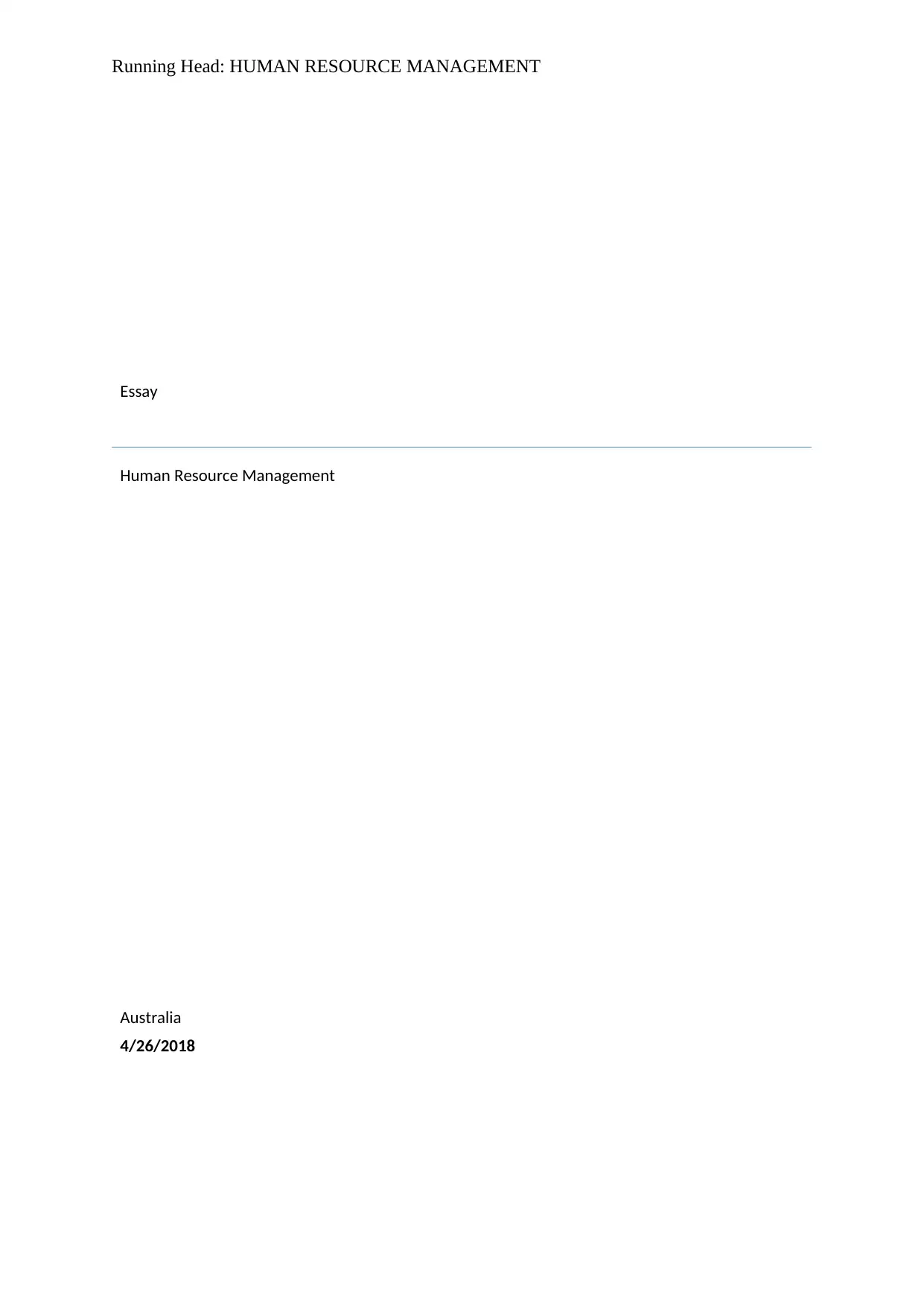
Running Head: HUMAN RESOURCE MANAGEMENT
Essay
Human Resource Management
Australia
4/26/2018
Essay
Human Resource Management
Australia
4/26/2018
Paraphrase This Document
Need a fresh take? Get an instant paraphrase of this document with our AI Paraphraser
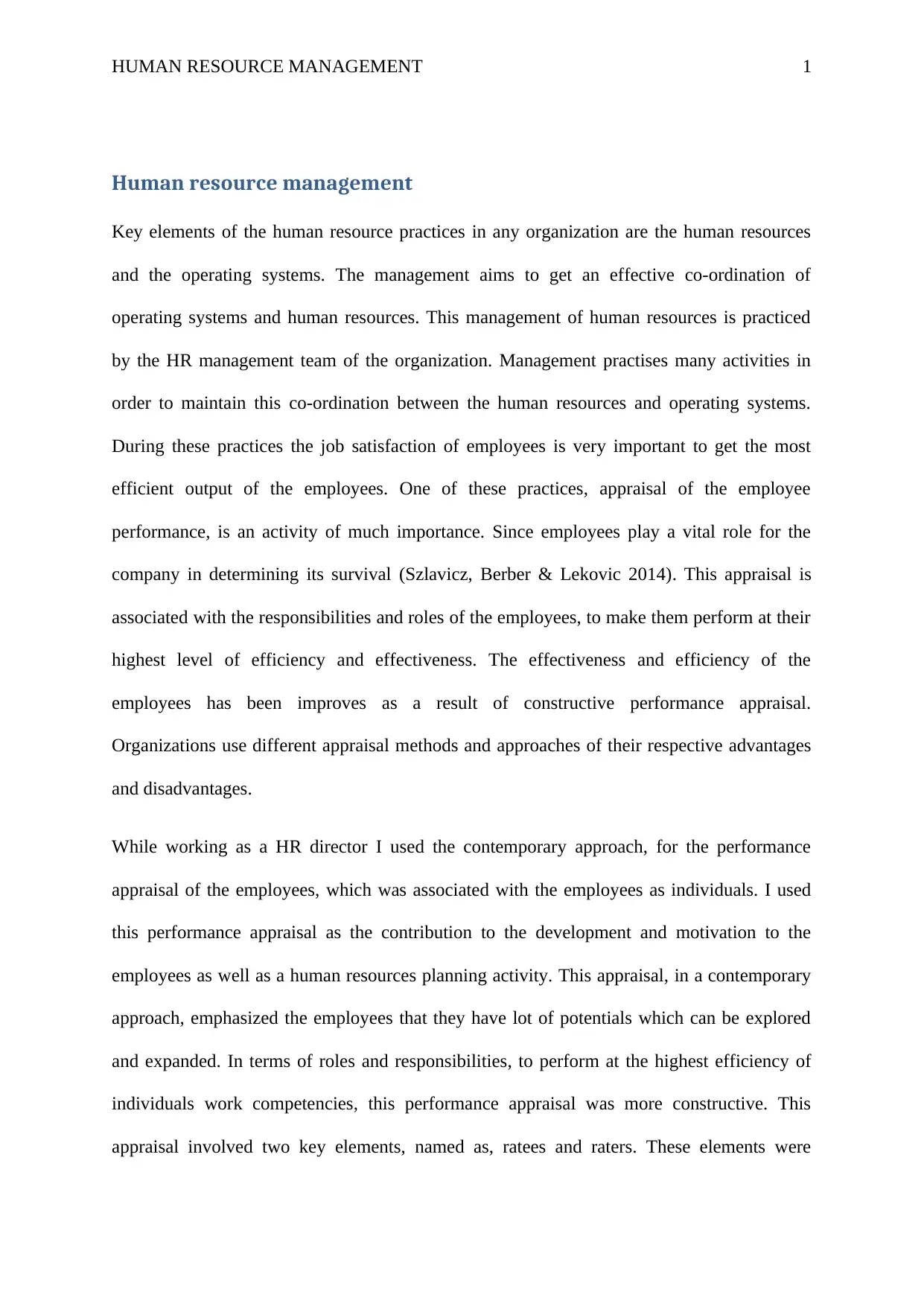
HUMAN RESOURCE MANAGEMENT 1
Human resource management
Key elements of the human resource practices in any organization are the human resources
and the operating systems. The management aims to get an effective co-ordination of
operating systems and human resources. This management of human resources is practiced
by the HR management team of the organization. Management practises many activities in
order to maintain this co-ordination between the human resources and operating systems.
During these practices the job satisfaction of employees is very important to get the most
efficient output of the employees. One of these practices, appraisal of the employee
performance, is an activity of much importance. Since employees play a vital role for the
company in determining its survival (Szlavicz, Berber & Lekovic 2014). This appraisal is
associated with the responsibilities and roles of the employees, to make them perform at their
highest level of efficiency and effectiveness. The effectiveness and efficiency of the
employees has been improves as a result of constructive performance appraisal.
Organizations use different appraisal methods and approaches of their respective advantages
and disadvantages.
While working as a HR director I used the contemporary approach, for the performance
appraisal of the employees, which was associated with the employees as individuals. I used
this performance appraisal as the contribution to the development and motivation to the
employees as well as a human resources planning activity. This appraisal, in a contemporary
approach, emphasized the employees that they have lot of potentials which can be explored
and expanded. In terms of roles and responsibilities, to perform at the highest efficiency of
individuals work competencies, this performance appraisal was more constructive. This
appraisal involved two key elements, named as, ratees and raters. These elements were
Human resource management
Key elements of the human resource practices in any organization are the human resources
and the operating systems. The management aims to get an effective co-ordination of
operating systems and human resources. This management of human resources is practiced
by the HR management team of the organization. Management practises many activities in
order to maintain this co-ordination between the human resources and operating systems.
During these practices the job satisfaction of employees is very important to get the most
efficient output of the employees. One of these practices, appraisal of the employee
performance, is an activity of much importance. Since employees play a vital role for the
company in determining its survival (Szlavicz, Berber & Lekovic 2014). This appraisal is
associated with the responsibilities and roles of the employees, to make them perform at their
highest level of efficiency and effectiveness. The effectiveness and efficiency of the
employees has been improves as a result of constructive performance appraisal.
Organizations use different appraisal methods and approaches of their respective advantages
and disadvantages.
While working as a HR director I used the contemporary approach, for the performance
appraisal of the employees, which was associated with the employees as individuals. I used
this performance appraisal as the contribution to the development and motivation to the
employees as well as a human resources planning activity. This appraisal, in a contemporary
approach, emphasized the employees that they have lot of potentials which can be explored
and expanded. In terms of roles and responsibilities, to perform at the highest efficiency of
individuals work competencies, this performance appraisal was more constructive. This
appraisal involved two key elements, named as, ratees and raters. These elements were
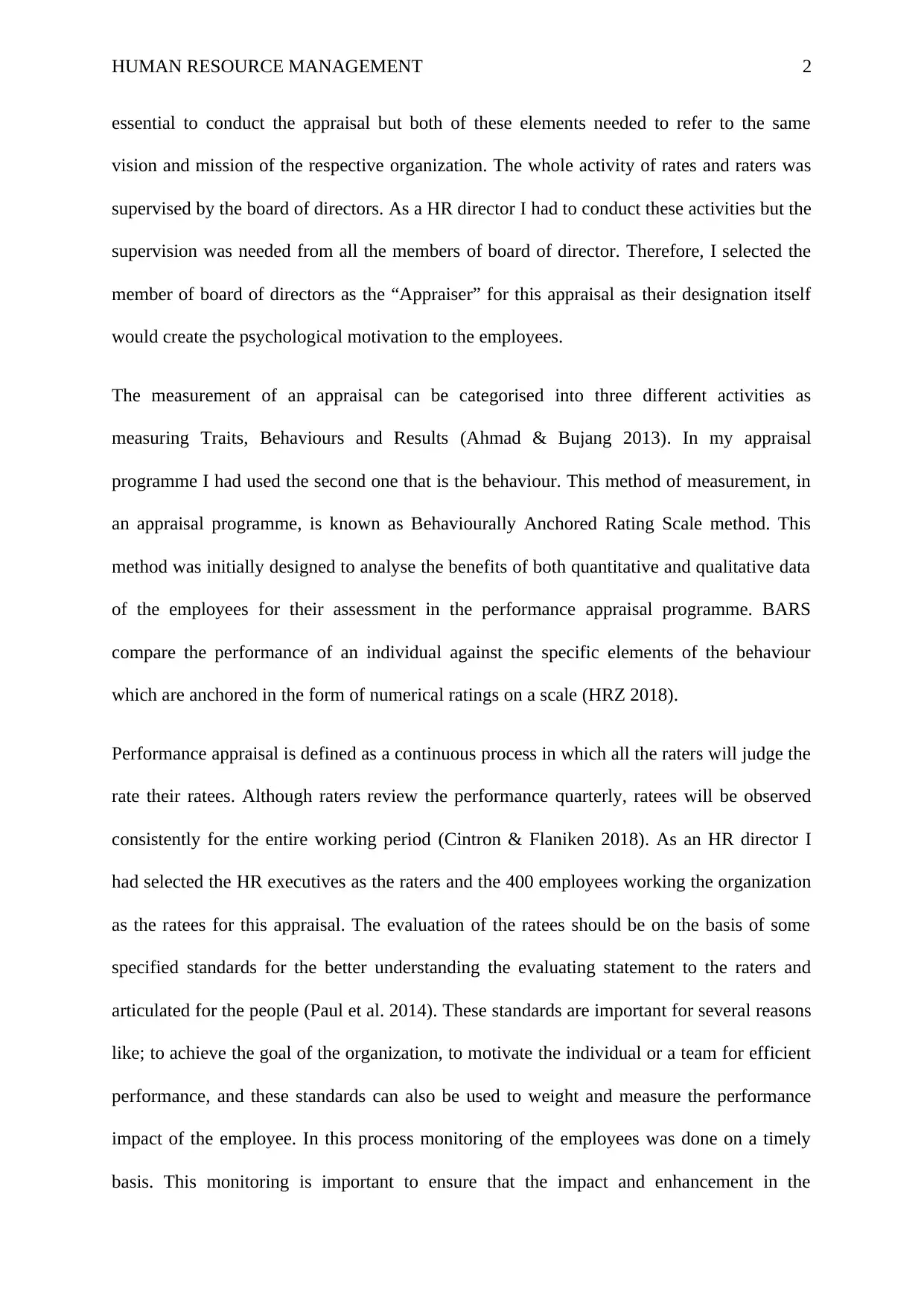
HUMAN RESOURCE MANAGEMENT 2
essential to conduct the appraisal but both of these elements needed to refer to the same
vision and mission of the respective organization. The whole activity of rates and raters was
supervised by the board of directors. As a HR director I had to conduct these activities but the
supervision was needed from all the members of board of director. Therefore, I selected the
member of board of directors as the “Appraiser” for this appraisal as their designation itself
would create the psychological motivation to the employees.
The measurement of an appraisal can be categorised into three different activities as
measuring Traits, Behaviours and Results (Ahmad & Bujang 2013). In my appraisal
programme I had used the second one that is the behaviour. This method of measurement, in
an appraisal programme, is known as Behaviourally Anchored Rating Scale method. This
method was initially designed to analyse the benefits of both quantitative and qualitative data
of the employees for their assessment in the performance appraisal programme. BARS
compare the performance of an individual against the specific elements of the behaviour
which are anchored in the form of numerical ratings on a scale (HRZ 2018).
Performance appraisal is defined as a continuous process in which all the raters will judge the
rate their ratees. Although raters review the performance quarterly, ratees will be observed
consistently for the entire working period (Cintron & Flaniken 2018). As an HR director I
had selected the HR executives as the raters and the 400 employees working the organization
as the ratees for this appraisal. The evaluation of the ratees should be on the basis of some
specified standards for the better understanding the evaluating statement to the raters and
articulated for the people (Paul et al. 2014). These standards are important for several reasons
like; to achieve the goal of the organization, to motivate the individual or a team for efficient
performance, and these standards can also be used to weight and measure the performance
impact of the employee. In this process monitoring of the employees was done on a timely
basis. This monitoring is important to ensure that the impact and enhancement in the
essential to conduct the appraisal but both of these elements needed to refer to the same
vision and mission of the respective organization. The whole activity of rates and raters was
supervised by the board of directors. As a HR director I had to conduct these activities but the
supervision was needed from all the members of board of director. Therefore, I selected the
member of board of directors as the “Appraiser” for this appraisal as their designation itself
would create the psychological motivation to the employees.
The measurement of an appraisal can be categorised into three different activities as
measuring Traits, Behaviours and Results (Ahmad & Bujang 2013). In my appraisal
programme I had used the second one that is the behaviour. This method of measurement, in
an appraisal programme, is known as Behaviourally Anchored Rating Scale method. This
method was initially designed to analyse the benefits of both quantitative and qualitative data
of the employees for their assessment in the performance appraisal programme. BARS
compare the performance of an individual against the specific elements of the behaviour
which are anchored in the form of numerical ratings on a scale (HRZ 2018).
Performance appraisal is defined as a continuous process in which all the raters will judge the
rate their ratees. Although raters review the performance quarterly, ratees will be observed
consistently for the entire working period (Cintron & Flaniken 2018). As an HR director I
had selected the HR executives as the raters and the 400 employees working the organization
as the ratees for this appraisal. The evaluation of the ratees should be on the basis of some
specified standards for the better understanding the evaluating statement to the raters and
articulated for the people (Paul et al. 2014). These standards are important for several reasons
like; to achieve the goal of the organization, to motivate the individual or a team for efficient
performance, and these standards can also be used to weight and measure the performance
impact of the employee. In this process monitoring of the employees was done on a timely
basis. This monitoring is important to ensure that the impact and enhancement in the
⊘ This is a preview!⊘
Do you want full access?
Subscribe today to unlock all pages.

Trusted by 1+ million students worldwide
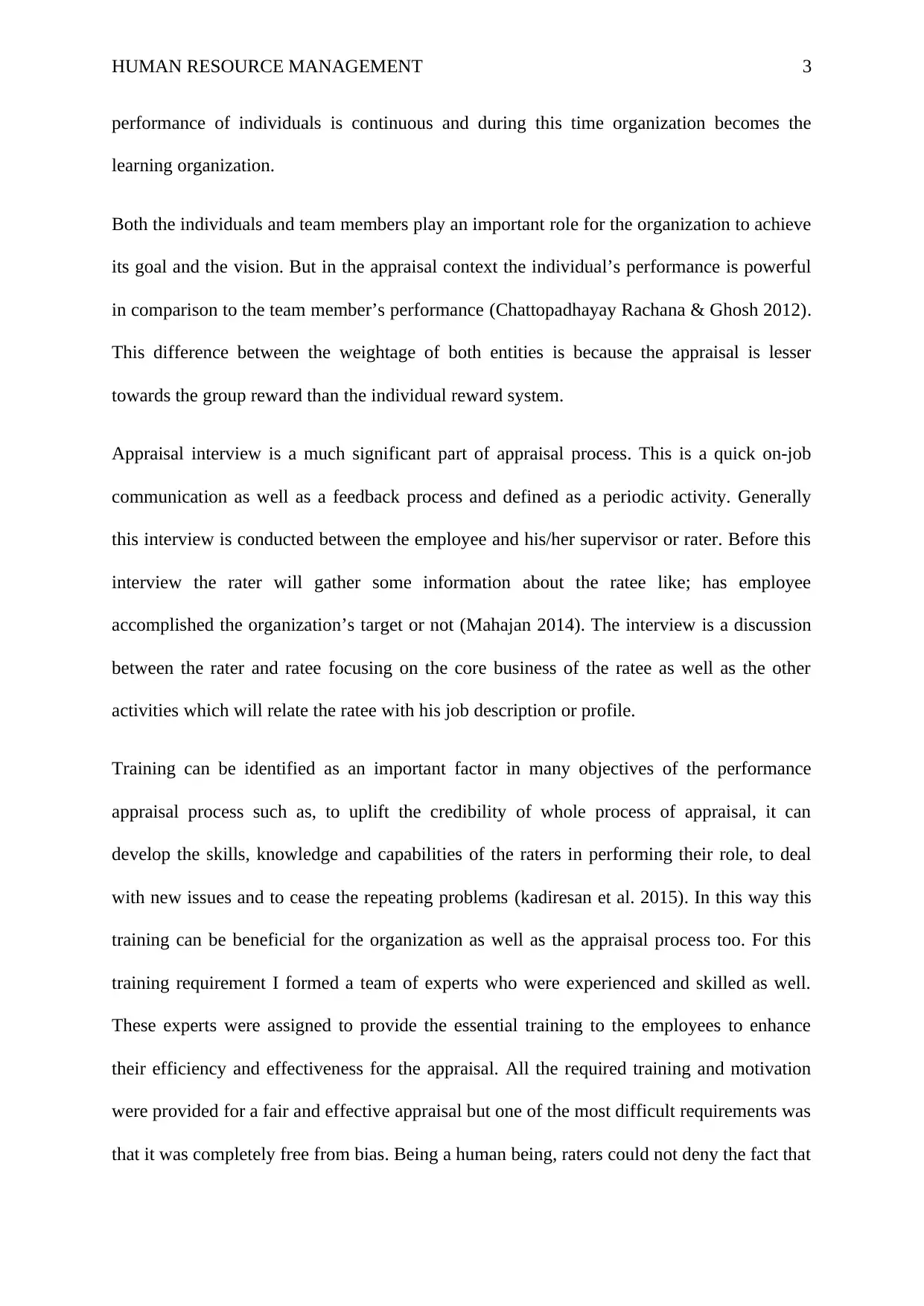
HUMAN RESOURCE MANAGEMENT 3
performance of individuals is continuous and during this time organization becomes the
learning organization.
Both the individuals and team members play an important role for the organization to achieve
its goal and the vision. But in the appraisal context the individual’s performance is powerful
in comparison to the team member’s performance (Chattopadhayay Rachana & Ghosh 2012).
This difference between the weightage of both entities is because the appraisal is lesser
towards the group reward than the individual reward system.
Appraisal interview is a much significant part of appraisal process. This is a quick on-job
communication as well as a feedback process and defined as a periodic activity. Generally
this interview is conducted between the employee and his/her supervisor or rater. Before this
interview the rater will gather some information about the ratee like; has employee
accomplished the organization’s target or not (Mahajan 2014). The interview is a discussion
between the rater and ratee focusing on the core business of the ratee as well as the other
activities which will relate the ratee with his job description or profile.
Training can be identified as an important factor in many objectives of the performance
appraisal process such as, to uplift the credibility of whole process of appraisal, it can
develop the skills, knowledge and capabilities of the raters in performing their role, to deal
with new issues and to cease the repeating problems (kadiresan et al. 2015). In this way this
training can be beneficial for the organization as well as the appraisal process too. For this
training requirement I formed a team of experts who were experienced and skilled as well.
These experts were assigned to provide the essential training to the employees to enhance
their efficiency and effectiveness for the appraisal. All the required training and motivation
were provided for a fair and effective appraisal but one of the most difficult requirements was
that it was completely free from bias. Being a human being, raters could not deny the fact that
performance of individuals is continuous and during this time organization becomes the
learning organization.
Both the individuals and team members play an important role for the organization to achieve
its goal and the vision. But in the appraisal context the individual’s performance is powerful
in comparison to the team member’s performance (Chattopadhayay Rachana & Ghosh 2012).
This difference between the weightage of both entities is because the appraisal is lesser
towards the group reward than the individual reward system.
Appraisal interview is a much significant part of appraisal process. This is a quick on-job
communication as well as a feedback process and defined as a periodic activity. Generally
this interview is conducted between the employee and his/her supervisor or rater. Before this
interview the rater will gather some information about the ratee like; has employee
accomplished the organization’s target or not (Mahajan 2014). The interview is a discussion
between the rater and ratee focusing on the core business of the ratee as well as the other
activities which will relate the ratee with his job description or profile.
Training can be identified as an important factor in many objectives of the performance
appraisal process such as, to uplift the credibility of whole process of appraisal, it can
develop the skills, knowledge and capabilities of the raters in performing their role, to deal
with new issues and to cease the repeating problems (kadiresan et al. 2015). In this way this
training can be beneficial for the organization as well as the appraisal process too. For this
training requirement I formed a team of experts who were experienced and skilled as well.
These experts were assigned to provide the essential training to the employees to enhance
their efficiency and effectiveness for the appraisal. All the required training and motivation
were provided for a fair and effective appraisal but one of the most difficult requirements was
that it was completely free from bias. Being a human being, raters could not deny the fact that
Paraphrase This Document
Need a fresh take? Get an instant paraphrase of this document with our AI Paraphraser
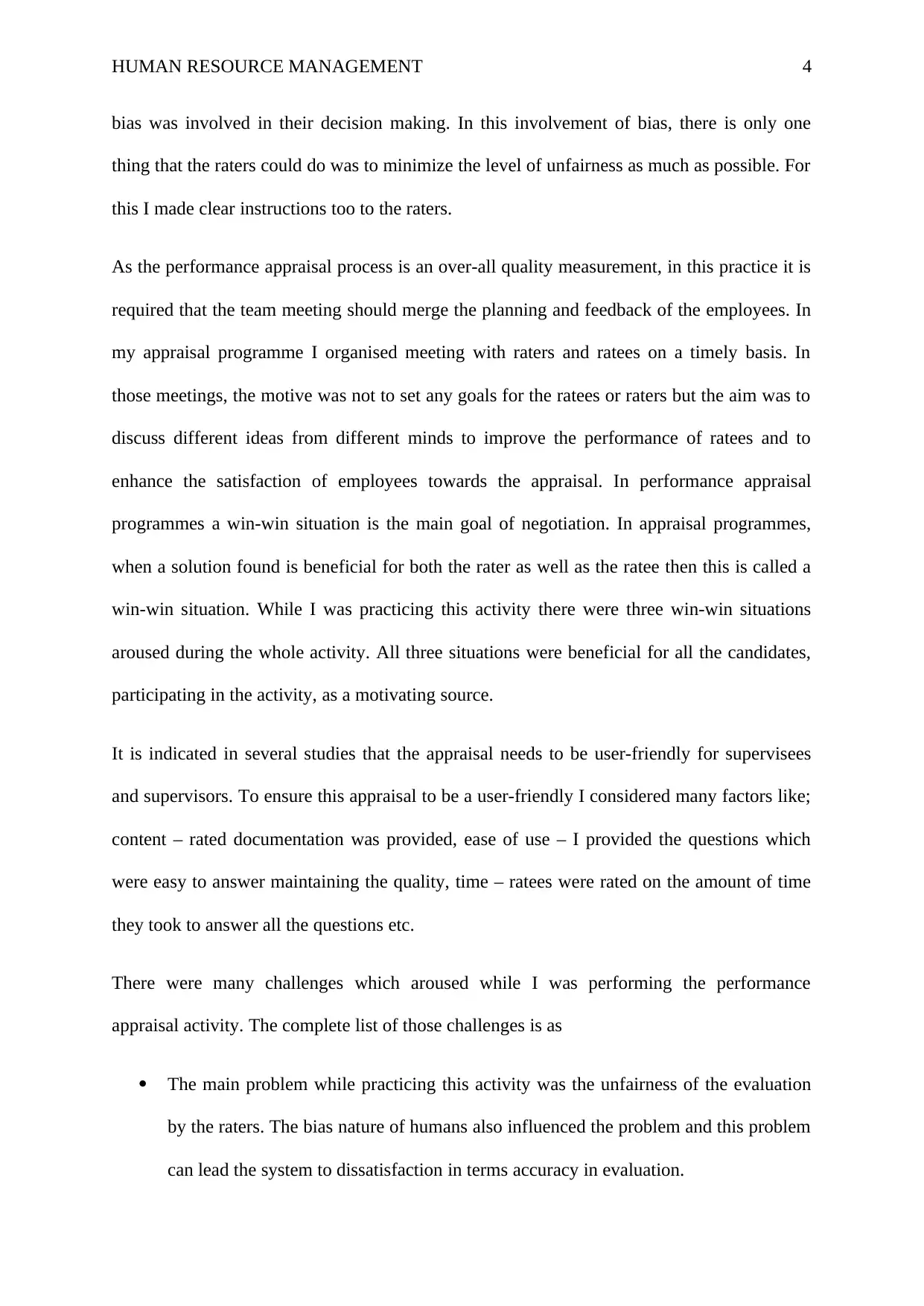
HUMAN RESOURCE MANAGEMENT 4
bias was involved in their decision making. In this involvement of bias, there is only one
thing that the raters could do was to minimize the level of unfairness as much as possible. For
this I made clear instructions too to the raters.
As the performance appraisal process is an over-all quality measurement, in this practice it is
required that the team meeting should merge the planning and feedback of the employees. In
my appraisal programme I organised meeting with raters and ratees on a timely basis. In
those meetings, the motive was not to set any goals for the ratees or raters but the aim was to
discuss different ideas from different minds to improve the performance of ratees and to
enhance the satisfaction of employees towards the appraisal. In performance appraisal
programmes a win-win situation is the main goal of negotiation. In appraisal programmes,
when a solution found is beneficial for both the rater as well as the ratee then this is called a
win-win situation. While I was practicing this activity there were three win-win situations
aroused during the whole activity. All three situations were beneficial for all the candidates,
participating in the activity, as a motivating source.
It is indicated in several studies that the appraisal needs to be user-friendly for supervisees
and supervisors. To ensure this appraisal to be a user-friendly I considered many factors like;
content – rated documentation was provided, ease of use – I provided the questions which
were easy to answer maintaining the quality, time – ratees were rated on the amount of time
they took to answer all the questions etc.
There were many challenges which aroused while I was performing the performance
appraisal activity. The complete list of those challenges is as
The main problem while practicing this activity was the unfairness of the evaluation
by the raters. The bias nature of humans also influenced the problem and this problem
can lead the system to dissatisfaction in terms accuracy in evaluation.
bias was involved in their decision making. In this involvement of bias, there is only one
thing that the raters could do was to minimize the level of unfairness as much as possible. For
this I made clear instructions too to the raters.
As the performance appraisal process is an over-all quality measurement, in this practice it is
required that the team meeting should merge the planning and feedback of the employees. In
my appraisal programme I organised meeting with raters and ratees on a timely basis. In
those meetings, the motive was not to set any goals for the ratees or raters but the aim was to
discuss different ideas from different minds to improve the performance of ratees and to
enhance the satisfaction of employees towards the appraisal. In performance appraisal
programmes a win-win situation is the main goal of negotiation. In appraisal programmes,
when a solution found is beneficial for both the rater as well as the ratee then this is called a
win-win situation. While I was practicing this activity there were three win-win situations
aroused during the whole activity. All three situations were beneficial for all the candidates,
participating in the activity, as a motivating source.
It is indicated in several studies that the appraisal needs to be user-friendly for supervisees
and supervisors. To ensure this appraisal to be a user-friendly I considered many factors like;
content – rated documentation was provided, ease of use – I provided the questions which
were easy to answer maintaining the quality, time – ratees were rated on the amount of time
they took to answer all the questions etc.
There were many challenges which aroused while I was performing the performance
appraisal activity. The complete list of those challenges is as
The main problem while practicing this activity was the unfairness of the evaluation
by the raters. The bias nature of humans also influenced the problem and this problem
can lead the system to dissatisfaction in terms accuracy in evaluation.
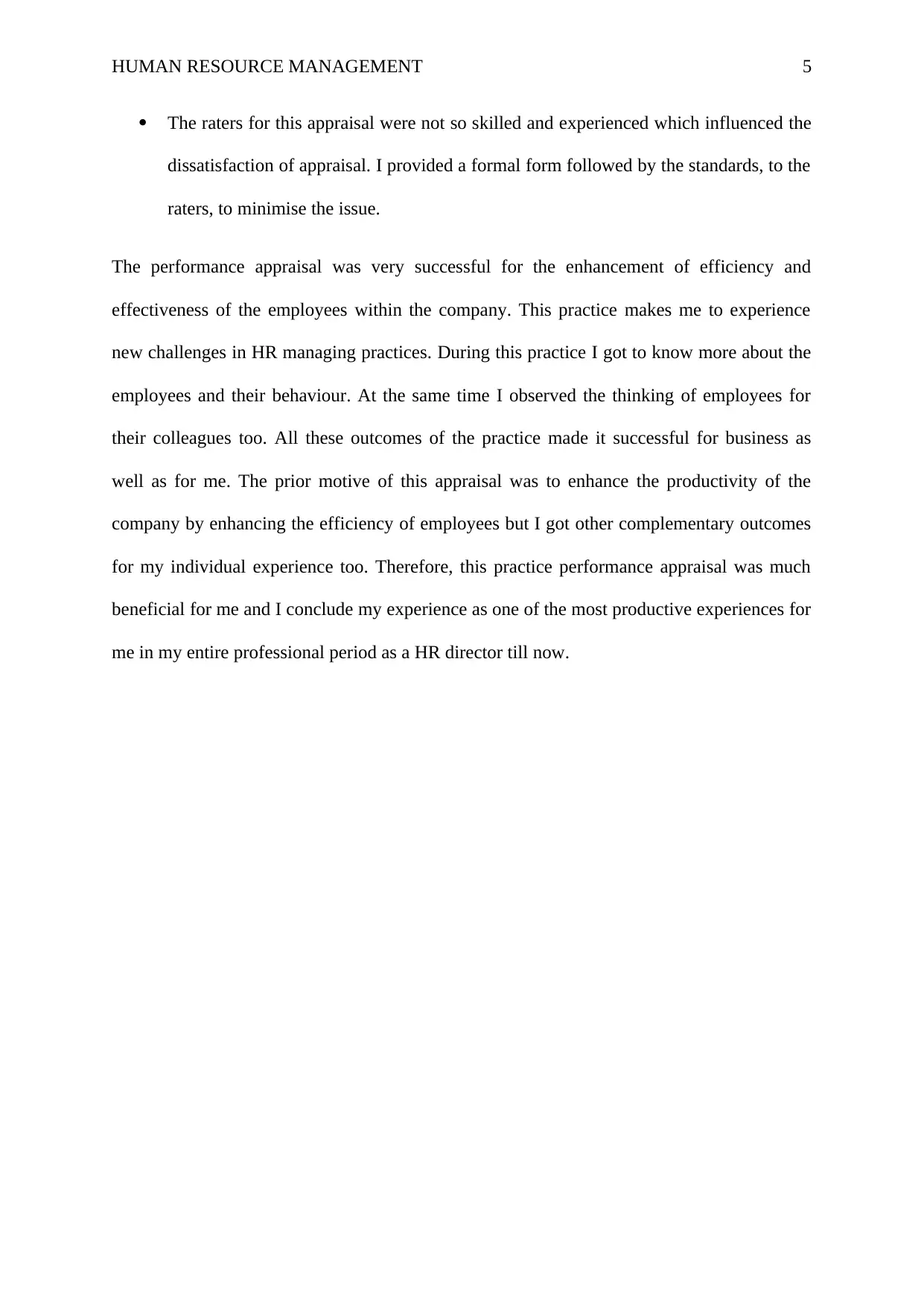
HUMAN RESOURCE MANAGEMENT 5
The raters for this appraisal were not so skilled and experienced which influenced the
dissatisfaction of appraisal. I provided a formal form followed by the standards, to the
raters, to minimise the issue.
The performance appraisal was very successful for the enhancement of efficiency and
effectiveness of the employees within the company. This practice makes me to experience
new challenges in HR managing practices. During this practice I got to know more about the
employees and their behaviour. At the same time I observed the thinking of employees for
their colleagues too. All these outcomes of the practice made it successful for business as
well as for me. The prior motive of this appraisal was to enhance the productivity of the
company by enhancing the efficiency of employees but I got other complementary outcomes
for my individual experience too. Therefore, this practice performance appraisal was much
beneficial for me and I conclude my experience as one of the most productive experiences for
me in my entire professional period as a HR director till now.
The raters for this appraisal were not so skilled and experienced which influenced the
dissatisfaction of appraisal. I provided a formal form followed by the standards, to the
raters, to minimise the issue.
The performance appraisal was very successful for the enhancement of efficiency and
effectiveness of the employees within the company. This practice makes me to experience
new challenges in HR managing practices. During this practice I got to know more about the
employees and their behaviour. At the same time I observed the thinking of employees for
their colleagues too. All these outcomes of the practice made it successful for business as
well as for me. The prior motive of this appraisal was to enhance the productivity of the
company by enhancing the efficiency of employees but I got other complementary outcomes
for my individual experience too. Therefore, this practice performance appraisal was much
beneficial for me and I conclude my experience as one of the most productive experiences for
me in my entire professional period as a HR director till now.
⊘ This is a preview!⊘
Do you want full access?
Subscribe today to unlock all pages.

Trusted by 1+ million students worldwide
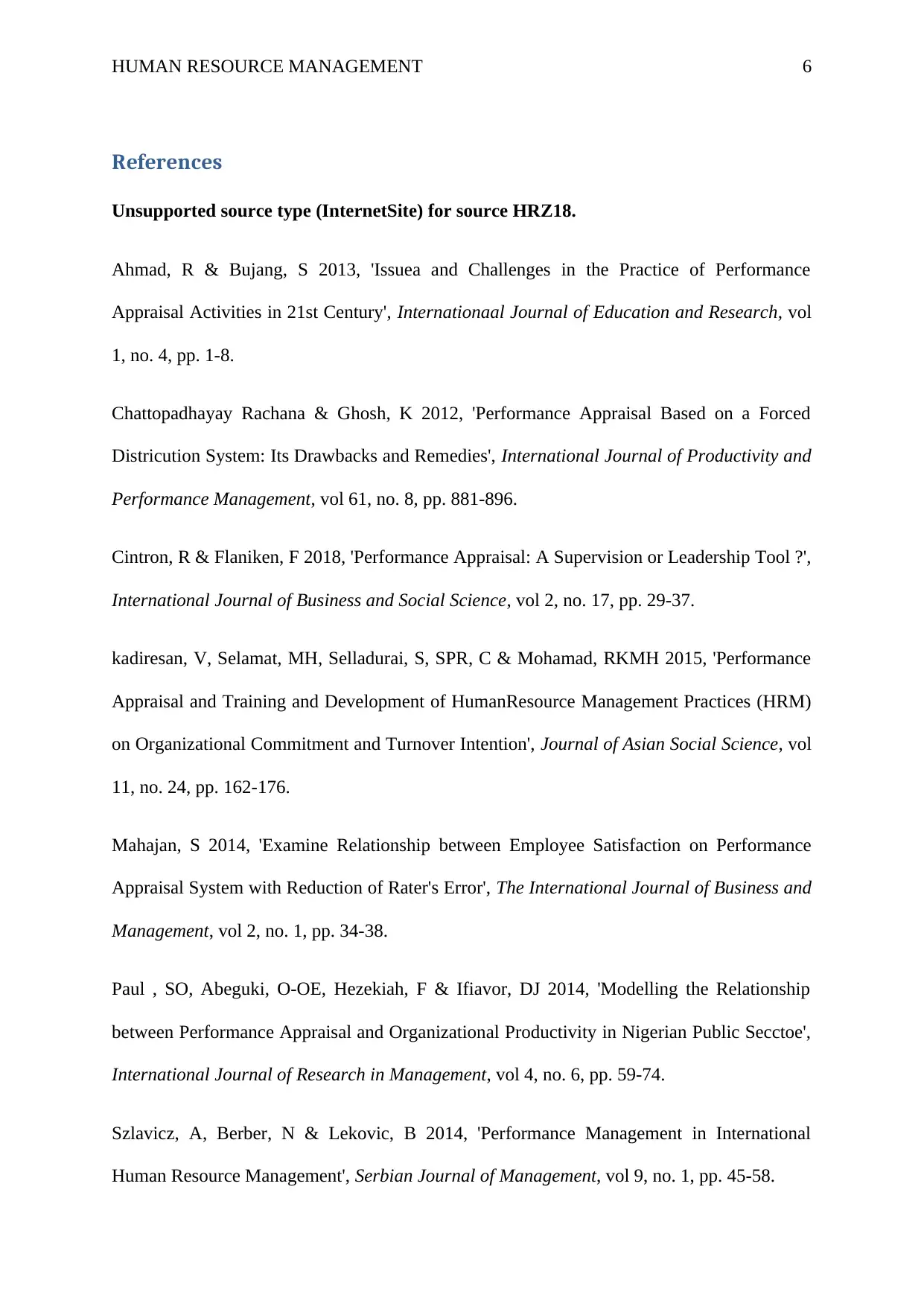
HUMAN RESOURCE MANAGEMENT 6
References
Unsupported source type (InternetSite) for source HRZ18.
Ahmad, R & Bujang, S 2013, 'Issuea and Challenges in the Practice of Performance
Appraisal Activities in 21st Century', Internationaal Journal of Education and Research, vol
1, no. 4, pp. 1-8.
Chattopadhayay Rachana & Ghosh, K 2012, 'Performance Appraisal Based on a Forced
Districution System: Its Drawbacks and Remedies', International Journal of Productivity and
Performance Management, vol 61, no. 8, pp. 881-896.
Cintron, R & Flaniken, F 2018, 'Performance Appraisal: A Supervision or Leadership Tool ?',
International Journal of Business and Social Science, vol 2, no. 17, pp. 29-37.
kadiresan, V, Selamat, MH, Selladurai, S, SPR, C & Mohamad, RKMH 2015, 'Performance
Appraisal and Training and Development of HumanResource Management Practices (HRM)
on Organizational Commitment and Turnover Intention', Journal of Asian Social Science, vol
11, no. 24, pp. 162-176.
Mahajan, S 2014, 'Examine Relationship between Employee Satisfaction on Performance
Appraisal System with Reduction of Rater's Error', The International Journal of Business and
Management, vol 2, no. 1, pp. 34-38.
Paul , SO, Abeguki, O-OE, Hezekiah, F & Ifiavor, DJ 2014, 'Modelling the Relationship
between Performance Appraisal and Organizational Productivity in Nigerian Public Secctoe',
International Journal of Research in Management, vol 4, no. 6, pp. 59-74.
Szlavicz, A, Berber, N & Lekovic, B 2014, 'Performance Management in International
Human Resource Management', Serbian Journal of Management, vol 9, no. 1, pp. 45-58.
References
Unsupported source type (InternetSite) for source HRZ18.
Ahmad, R & Bujang, S 2013, 'Issuea and Challenges in the Practice of Performance
Appraisal Activities in 21st Century', Internationaal Journal of Education and Research, vol
1, no. 4, pp. 1-8.
Chattopadhayay Rachana & Ghosh, K 2012, 'Performance Appraisal Based on a Forced
Districution System: Its Drawbacks and Remedies', International Journal of Productivity and
Performance Management, vol 61, no. 8, pp. 881-896.
Cintron, R & Flaniken, F 2018, 'Performance Appraisal: A Supervision or Leadership Tool ?',
International Journal of Business and Social Science, vol 2, no. 17, pp. 29-37.
kadiresan, V, Selamat, MH, Selladurai, S, SPR, C & Mohamad, RKMH 2015, 'Performance
Appraisal and Training and Development of HumanResource Management Practices (HRM)
on Organizational Commitment and Turnover Intention', Journal of Asian Social Science, vol
11, no. 24, pp. 162-176.
Mahajan, S 2014, 'Examine Relationship between Employee Satisfaction on Performance
Appraisal System with Reduction of Rater's Error', The International Journal of Business and
Management, vol 2, no. 1, pp. 34-38.
Paul , SO, Abeguki, O-OE, Hezekiah, F & Ifiavor, DJ 2014, 'Modelling the Relationship
between Performance Appraisal and Organizational Productivity in Nigerian Public Secctoe',
International Journal of Research in Management, vol 4, no. 6, pp. 59-74.
Szlavicz, A, Berber, N & Lekovic, B 2014, 'Performance Management in International
Human Resource Management', Serbian Journal of Management, vol 9, no. 1, pp. 45-58.
Paraphrase This Document
Need a fresh take? Get an instant paraphrase of this document with our AI Paraphraser
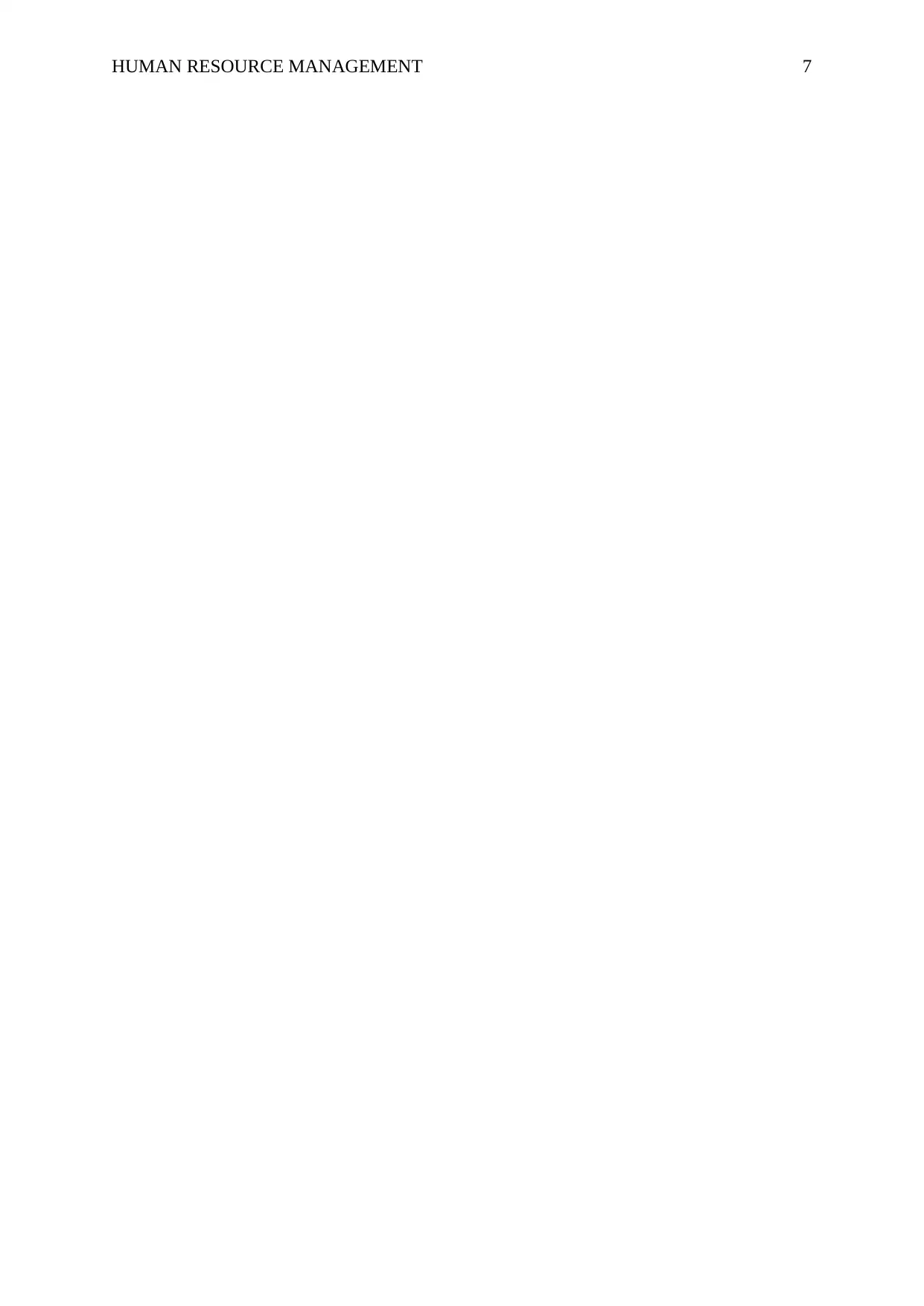
HUMAN RESOURCE MANAGEMENT 7
1 out of 8
Related Documents
Your All-in-One AI-Powered Toolkit for Academic Success.
+13062052269
info@desklib.com
Available 24*7 on WhatsApp / Email
![[object Object]](/_next/static/media/star-bottom.7253800d.svg)
Unlock your academic potential
Copyright © 2020–2025 A2Z Services. All Rights Reserved. Developed and managed by ZUCOL.





